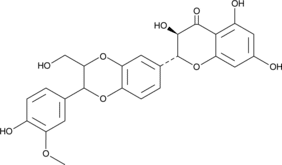Territorial Availability: Available through Bertin Technologies only in France
- Synonyms
- (2R,3R)-2-[2,3-dihydro-2-(4-hydroxy-3-methoxyphenyl)-3-(hydroxymethyl)-1,4-benzodioxin-6-yl]-2,3-dihydro-3,5,7-trihydroxy-4H-1-benzopyran-4-one
- Correlated keywords
- Silybum anti-oxidant anti-cancer HT22 1-C-1 C1 AKCR-1-C2 2 DU-145 CD-31 VEGFR-1 2 HIF1? noncancerous HO1
- Product Overview:
Isosilybin is a flavanolignan found in the extract of S. marianum fruits with antioxidant and anticancer activities.{12612,39717,39716} It inhibits lipid peroxidation in rat liver microsomes (IC50 = 32 ?M) and reduces ADP/Fe3+-induced malondialdehyde (MDA) production and lactate dehydrogenase (LDH) release in rat hepatocytes.{12612} Isosilybin inhibits the production of reactive oxygen species (ROS), MDA and LDH release, and reduction in total antioxidant capacity induced by amyloid-? (25-35) (A?25-35) in HT-22 hippocampal cells.{39717} It also increases protein and mRNA expression of heme oxygenase-1 (HO-1), glutathione S-transferase (GST), and the aldo-keto reductases (AKCR) 1C1 and AKCR1C2 in HT-22 cells. In vivo, isosilybin (50 and 100 mg/kg) reduces tumor volume and increases tumor cell apoptosis in a DU145 prostate cancer mouse xenograft model.{39716} It also reduces expression of the tumor angiogenesis markers CD31, nestin, VEGF, VEGFR1, VEGFR2, phospho-Akt, and HIF-1? in tumor tissue without reducing blood vessel count in non-cancerous liver, lung, and kidney tissue in DU145 tumor-bearing mice.
Cayman Chemical’s mission is to help make research possible by supplying scientists worldwide with the basic research tools necessary for advancing human and animal health. Our utmost commitment to healthcare researchers is to offer the highest quality products with an affordable pricing policy.
Our scientists are experts in the synthesis, purification, and characterization of biochemicals ranging from small drug-like heterocycles to complex biolipids, fatty acids, and many others. We are also highly skilled in all aspects of assay and antibody development, protein expression, crystallization, and structure determination.
Over the past thirty years, Cayman developed a deep knowledge base in lipid biochemistry, including research involving the arachidonic acid cascade, inositol phosphates, and cannabinoids. This knowledge enabled the production of reagents of exceptional quality for cancer, oxidative injury, epigenetics, neuroscience, inflammation, metabolism, and many additional lines of research.
Our organic and analytical chemists specialize in the rapid development of manufacturing processes and analytical methods to carry out clinical and commercial GMP-API production. Pre-clinical drug discovery efforts are currently underway in the areas of bone restoration and repair, muscular dystrophy, oncology, and inflammation. A separate group of Ph.D.-level scientists are dedicated to offering Hit-to-Lead Discovery and Profiling Services for epigenetic targets. Our knowledgeable chemists can be contracted to perform complete sample analysis for analytes measured by the majority of our assays. We also offer a wide range of analytical services using LC-MS/MS, HPLC, GC, and many other techniques.
Accreditations
ISO/IEC 17025:2005
ISO Guide 34:2009
Cayman is a leader in the field of emerging drugs of abuse, providing high-purity Schedule I-V Controlled Substances to federally-licensed laboratories and qualified academic research institutions for forensic analyses. We are certified by ACLASS Accreditation Services with dual accreditation to ISO/IEC 17025:2005 and ISO Guide 34:2009.





